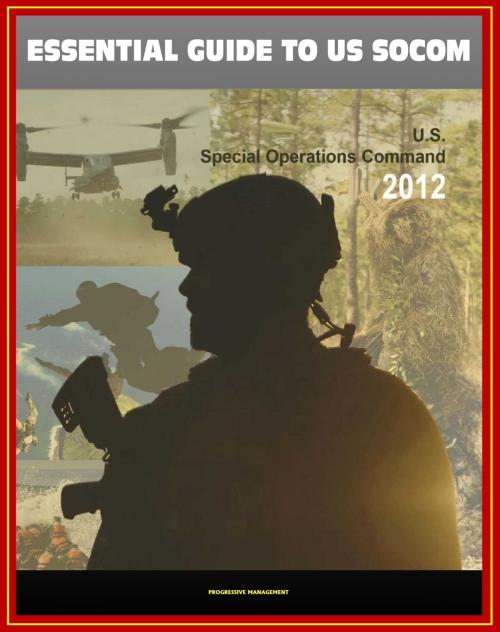2012 Essential Guide to United States Special Operations Command (USSOCOM) - SEALS, Army Rangers, Milestones, Aircraft, Weapons, UAS, Maritime Surface Platforms, Missions, Strategic Plan, Factbooks
Nonfiction, History, Military, Social & Cultural Studies, Political Science| Author: | Progressive Management | ISBN: | 9781476353296 |
| Publisher: | Progressive Management | Publication: | April 14, 2012 |
| Imprint: | Smashwords Edition | Language: | English |
| Author: | Progressive Management |
| ISBN: | 9781476353296 |
| Publisher: | Progressive Management |
| Publication: | April 14, 2012 |
| Imprint: | Smashwords Edition |
| Language: | English |
This unique compilation of five U.S. Special Operations Command (SOCOM) documents provides essential information about the weapons, teams, aircraft, mission and responsibilities of America's special warfare and anti-terrorism forces, including the U.S. Navy SEALS and the Army Rangers. Coverage includes maritime surface platforms, unmanned aircraft systems (UAS), the USSOCOM strategic plan, the Emerald Warrior exercise, Warfighter Challenges (WFC), FY2013 budget highlights, and more.
Over the years, USSOCOM's missions and organizational structure have evolved to meet the needs of modern warfare. Originally, the command's mission was "to prepare SOF to carry out missions and, if directed by the President or the Secretary of Defense, to plan and conduct special operations." Commanders refined the mission statement over the years to reflect the need and role of SOF during their periods of time in command. Upon becoming USSOCOM commander, Olson further refined the mission: "Provide fully capable Special Operations Forces to defend the United States and its interests. Plan and synchronize operations against terrorist networks."
SOF deployments have greatly increased since USSOCOM's inception, measured by both personnel deployed and the number of countries visited. Currently, approximately 58,000 servicemembers and civilians work at USSOCOM headquarters or one of its unified commands: U.S. Army Special Operations Command, Naval Special Warfare Command, Air Force Special Operations Command, Marine Corps Forces Special Operations Command, and Joint Special Operations Command, a sub-unified command.
U.S. Army Special Operations Command was established Dec. 1, 1989, by the Department of the Army at Fort Bragg, N.C., as an Army Service Component Command to enhance the readiness of Army Special Operations Forces. USASOC is home to the fighting forces that conduct operations across the full spectrum of warfare, including unconventional warfare, counter-proliferation, direct action, military information support operations, special reconnaissance, civil affairs, foreign internal defense and information operations. USASOC commands and controls two component subordinate commands and five component subordinate units, which in turn train and maintain forces for deployment by USSOCOM to combatant command theaters worldwide.
USASOC's two component subordinate commands are U.S. Army John F. Kennedy Special Warfare Center and School and the U.S. Army Special Forces Command (Airborne) both headquartered at Fort Bragg. The component subordinate units include the 75th Ranger Regiment, headquartered at Fort Benning, Ga.; 160th Special Operations Aviation Regiment (Airborne) at Fort Campbell, Ky.; 4th Military Information Support Group (Airborne), 95th Civil Affairs Brigade (Airborne) and 528th Sustainment Brigade (Special Operations) (Airborne), all at Fort Bragg.
This unique compilation of five U.S. Special Operations Command (SOCOM) documents provides essential information about the weapons, teams, aircraft, mission and responsibilities of America's special warfare and anti-terrorism forces, including the U.S. Navy SEALS and the Army Rangers. Coverage includes maritime surface platforms, unmanned aircraft systems (UAS), the USSOCOM strategic plan, the Emerald Warrior exercise, Warfighter Challenges (WFC), FY2013 budget highlights, and more.
Over the years, USSOCOM's missions and organizational structure have evolved to meet the needs of modern warfare. Originally, the command's mission was "to prepare SOF to carry out missions and, if directed by the President or the Secretary of Defense, to plan and conduct special operations." Commanders refined the mission statement over the years to reflect the need and role of SOF during their periods of time in command. Upon becoming USSOCOM commander, Olson further refined the mission: "Provide fully capable Special Operations Forces to defend the United States and its interests. Plan and synchronize operations against terrorist networks."
SOF deployments have greatly increased since USSOCOM's inception, measured by both personnel deployed and the number of countries visited. Currently, approximately 58,000 servicemembers and civilians work at USSOCOM headquarters or one of its unified commands: U.S. Army Special Operations Command, Naval Special Warfare Command, Air Force Special Operations Command, Marine Corps Forces Special Operations Command, and Joint Special Operations Command, a sub-unified command.
U.S. Army Special Operations Command was established Dec. 1, 1989, by the Department of the Army at Fort Bragg, N.C., as an Army Service Component Command to enhance the readiness of Army Special Operations Forces. USASOC is home to the fighting forces that conduct operations across the full spectrum of warfare, including unconventional warfare, counter-proliferation, direct action, military information support operations, special reconnaissance, civil affairs, foreign internal defense and information operations. USASOC commands and controls two component subordinate commands and five component subordinate units, which in turn train and maintain forces for deployment by USSOCOM to combatant command theaters worldwide.
USASOC's two component subordinate commands are U.S. Army John F. Kennedy Special Warfare Center and School and the U.S. Army Special Forces Command (Airborne) both headquartered at Fort Bragg. The component subordinate units include the 75th Ranger Regiment, headquartered at Fort Benning, Ga.; 160th Special Operations Aviation Regiment (Airborne) at Fort Campbell, Ky.; 4th Military Information Support Group (Airborne), 95th Civil Affairs Brigade (Airborne) and 528th Sustainment Brigade (Special Operations) (Airborne), all at Fort Bragg.















